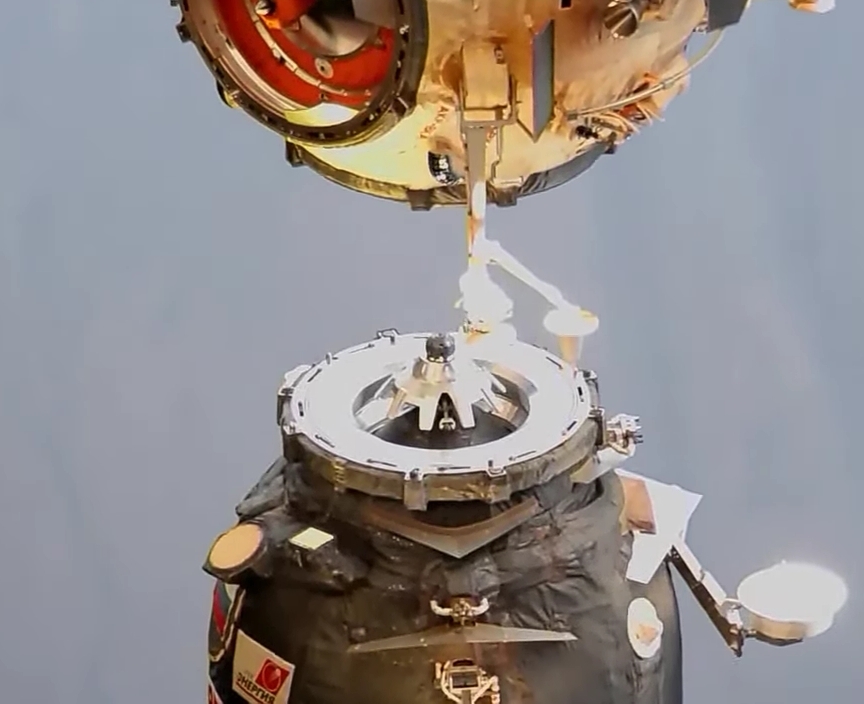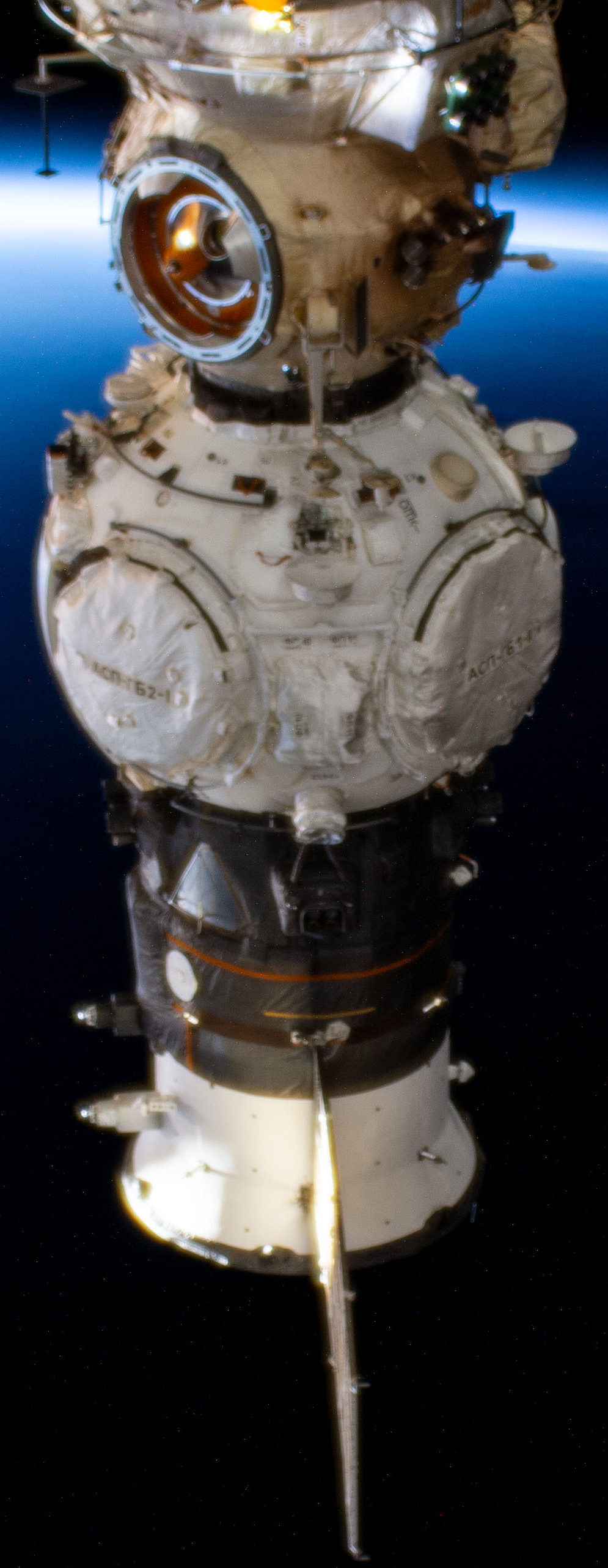Progress M-UM on:
[Wikipedia]
[Google]
[Amazon]
Progress M-UM (), was a specially modified
 A
A


 Two days after launch, Progress M-UM automatically docked ''Prichal'' to the re-configured
Two days after launch, Progress M-UM automatically docked ''Prichal'' to the re-configured
 The ISS flight manifest drafted by
The ISS flight manifest drafted by

 The Progress M-UM propulsion section is remained docked at the station for 26 days. The propulsion section then undocked, revealing ''Prichal''s nadir docking port for future Russian spacecraft.
The Progress M-UM propulsion section is remained docked at the station for 26 days. The propulsion section then undocked, revealing ''Prichal''s nadir docking port for future Russian spacecraft.
 The propulsion section re-entered the
The propulsion section re-entered the
Russian Launch Manifest dated 23 July 2014
{{Orbital launches in 2021 Progress (spacecraft) missions 2021 in Russia Supply vehicles for the International Space Station Spacecraft launched by Soyuz-2 rockets Spacecraft launched in 2021 Spacecraft which reentered in 2021
Progress M
Progress-M (russian: Прогресс-М, GRAU indices 11F615A55 and 11F615A60), also known as Progress 7K-TGM, is a Russian, previously Soviet spacecraft which is used to resupply space stations. It is a variant of the Progress spacecraft, o ...
11F615A55, Russian production No.303, developed by Roscosmos
The State Space Corporation "Roscosmos" (russian: Государственная корпорация по космической деятельности «Роскосмос»), commonly known simply as Roscosmos (russian: Роскосмос) ...
to deliver the ''Prichal'' module to the Russian Orbital Segment
The Russian Orbital Segment (ROS) is the name given to the components of the International Space Station (ISS) constructed in Russia and operated by the Russian Roscosmos. The ROS handles Guidance, Navigation, and Control for the entire Station. ...
(ROS) of the International Space Station
The International Space Station (ISS) is the largest modular space station currently in low Earth orbit. It is a multinational collaborative project involving five participating space agencies: NASA (United States), Roscosmos (Russia), JAXA ...
(ISS). It was launched on 24 November 2021 at 13:06:35 UTC, along with a Progress M propulsion compartment and has the pressurised cargo module removed to accommodate ''Prichal''. This was the 171st flight of a Progress spacecraft. It was the final flight of a Progress M and the first launch of a Progress spacecraft on a Soyuz 2.1b.
Development
On 15 January 2011, RKK Energia announced that its Scientific and Technical Council (NTS) had reviewed and approved the preliminary design of the Node Module and associated hardware, including a special version of the Progress cargo ship designated the Progress M-UM spacecraft-module, intended for the delivery of the Node Module to the station. The space payload section for the Progress M-UM was dubbed KGCh. TheSoyuz-2
Soyuz-2 (GRAU index 14A14) is a modernized version of the Soviet Soyuz rocket. In its basic form, it is a three-stage launch vehicle for placing payloads into low Earth orbit. Compared to the previous versions of the Soyuz, the first-stage bo ...
launch vehicle was adapted for the launch of the Progress M-UM spacecraft-module, originally envisioned to take place in 2012, then 2019. It was eventually signed for as completed in 2014 and kept in storage until processing and attachment with ''Prichal'' was started for launch in 2021. It is attached to the ''Prichal'' module by means of a newly developed transition compartment.
The ''Prichal'' module was the second addition to the ROS in 2021. Earlier modules were delivered and added in a similar manner. Progress M-UM is similar in design to Progress DC-1 that delivered ''Pirs'' in 2001 and Progress M-MIM2
Progress M-MIM2 (russian: Прогресс М-МИМ2), or Progress M-MRM2, originally designated Progress M-SO2, was a modified Progress-M 11F615A55, Russian production No. 302, which was used to deliver the '' Poisk'' module to the International ...
that delivered ''Poisk'' in 2009, but with navigational systems and avionics hardware taken from the Progress MS
The Progress (russian: Прогресс) is a Russian expendable cargo spacecraft. Its purpose is to deliver the supplies needed to sustain a human presence in orbit. While it does not carry a crew, it can be boarded by astronauts when docked t ...
variant.
Launch
 A
A Soyuz-2.1b
Soyuz-2 (GRAU index 14A14) is a modernized version of the Soviet Soyuz rocket. In its basic form, it is a three-stage launch vehicle for placing payloads into low Earth orbit. Compared to the previous versions of the Soyuz, the first-stage bo ...
launched Progress M-UM to the International Space Station from Baikonur Site 31/6 on 24 November 2021, at 13:06:40 UTC for delivery of the Prichal module. Due to the larger diameter of the ''Prichal'' module, the Progress M-UM was launched in a wide ST-type fairing.
Docking


 Two days after launch, Progress M-UM automatically docked ''Prichal'' to the re-configured
Two days after launch, Progress M-UM automatically docked ''Prichal'' to the re-configured nadir
The nadir (, ; ar, نظير, naẓīr, counterpart) is the direction pointing directly ''below'' a particular location; that is, it is one of two vertical directions at a specified location, orthogonal to a horizontal flat surface.
The direc ...
(or Earth-facing) port of the ''Nauka'' module after removal of the module's nadir docking adapter by Progress MS-17
Progress MS-17 (), Russian production No. 446, identified by NASA as Progress 78P, was a Progress spaceflight operated by Roscosmos to resupply the International Space Station (ISS). This was the 169th flight of a Progress spacecraft.
History ...
. Progress M-UM, was later undocked and deorbited after 28 days and 15 hours in space.
Expansion of Russian Orbital Segment
 The ISS flight manifest drafted by
The ISS flight manifest drafted by Roscosmos
The State Space Corporation "Roscosmos" (russian: Государственная корпорация по космической деятельности «Роскосмос»), commonly known simply as Roscosmos (russian: Роскосмос) ...
at the end of summer 2020 set the launch of the ''Prichal'' module for 6 September 2021, with the docking to ''Nauka''s nadir port two days later. However, on 1 December 2020, the launch of ''Prichal'' slipped to three and four months after the ''Nauka''. The planned launch date was on 24 November 2021.
One port on ''Prichal'' is equipped with an active hybrid docking port, which enables docking with the ''Nauka'' module. The remaining five ports are passive hybrids, enabling docking of Soyuz and Progress vehicles, as well as heavier modules and future spacecraft with modified docking systems. Eight spacewalks will follow in 2022 to complete the integration of the ''Nauka'' and ''Prichal'' modules into the Russian Orbital Segment.
Undocking

 The Progress M-UM propulsion section is remained docked at the station for 26 days. The propulsion section then undocked, revealing ''Prichal''s nadir docking port for future Russian spacecraft.
The Progress M-UM propulsion section is remained docked at the station for 26 days. The propulsion section then undocked, revealing ''Prichal''s nadir docking port for future Russian spacecraft.
Atmospheric entry
 The propulsion section re-entered the
The propulsion section re-entered the atmosphere of Earth
The atmosphere of Earth is the layer of gases, known collectively as air, retained by Earth's gravity that surrounds the planet and forms its planetary atmosphere. The atmosphere of Earth protects life on Earth by creating pressure allowing for ...
for destruction over the South Pacific Ocean
South is one of the cardinal directions or compass points. The direction is the opposite of north and is perpendicular to both east and west.
Etymology
The word ''south'' comes from Old English ''sūþ'', from earlier Proto-Germanic ''*sunþaz ...
, on 23 December 2021, at 04:30:54.
See also
*Prichal (ISS module)
''Prichal'' nodal module also known as Uzlovoy Module or UM (russian: Узловой Модуль "Причал", ''Nodal Module Berth'') is a Russian spacecraft which is part of the International Space Station (ISS). It was approved in 2011 ...
* Uncrewed spaceflights to the International Space Station
Uncrewed spaceflights to the International Space Station (ISS) are made primarily to deliver cargo, however several Russian modules have also docked to the outpost following uncrewed launches. Resupply missions typically use the Russian Progress s ...
* Orbital Piloted Assembly and Experiment Complex
The Orbital Piloted Assembly and Experiment Complex (russian: Орбитальный Пилотируемый Сборочно-Экспериментальный Комплекс, ''Orbital'nyj Pilotirujemyj Sborochno-Eksperimental'nyj Kompl ...
- proposed complex (scrapped in September 2017)
* Universal Docking Module
The Universal Docking Module (UDM) (russian: Универсальный стыковочный модуль), was a planned Russian docking module for the International Space Station, to be jointly built by RKK Energia and Khrunichev. The ''Pric ...
- former name Uzlovoy Module (eventually ''Prichal'')
Notes
References
Russian Launch Manifest dated 23 July 2014
{{Orbital launches in 2021 Progress (spacecraft) missions 2021 in Russia Supply vehicles for the International Space Station Spacecraft launched by Soyuz-2 rockets Spacecraft launched in 2021 Spacecraft which reentered in 2021